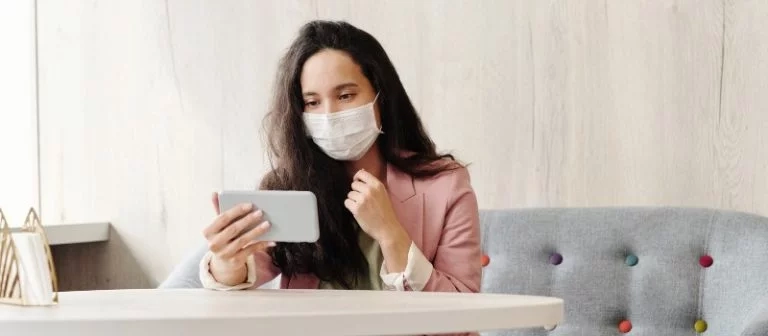Teleconsultation, a practice that appeals
to occupational medicine structures



Still unknow a few months ago, telemedicine is now a common practice. After a significant growth during the COVID-19 pandemic, the use of telemedicine seems to be establishing in the habits of practitioners and patients over the long term. In the occupational medicine sector, teleconsultation has also proved its worth during the health crisis and many occupational medicine structures have been won over this tool with multiple advantages.
The use of telemedicine in occupational health grew during the COVID-19 pandemic. Occupational health organisations had to adapt quickly to the health situation in order to comply with measures to restrict movement and limit contact between individuals. While in some companies, medical visits have been postponed, others have opted for the implementation of teleconsultation in order to be able to ensure the continuity of the individual monitoring of employees.
Like the questions about the deployment of “post-crisis” teleworking, the use of teleconsultation in the occupational health structures after the epidemic crisis will undoubtedly continue to accelerate. Occupational health structures face two major problems: the shortage of occupational physicians and the growing demand for occupational health. Faced with these important issues, teleconsultation could be an interesting solution to ensure access to an occupational doctor for all employees and to improve the efficiency and quality of occupational health consultations.
The shortage of occupational physicians in Europe is a matter of concern as it will continue to worsen in the years to come. As an example, in ten years, France has lost 30% of the number of occupational physicians. The aging of the workforce is the main reason for this shortage phenomenon since in 2018, 75% of occupational physicians were over 55 years old. In addition, retirements are hardly compensated by the arrival of new doctors. In fact, there are around 300 departures for less than 100 people entering occupational medicine per year.

Although teleconsultation does not make it possible to increase the workforce, it does, on the other hand, make it possible to reorganize the existing offer in a territory and to optimize the use of available human resources. By making it possible to carry out remote consultations regardless of the geographical location of the employees, teleconsultation offers many possibilities in terms of the organization of visits. In general, teleconsultation facilitates and maintains access for all employees to an occupational doctor while ensuring effective and quality care.
Teleconsultation benefits employees, employers and occupational physicians alike. For all parties, remote consultation avoids unnecessary travel and saves time. The employer benefits from the reduction in employee absence time from the company and the ease of fulfilling their legal obligations within the time limits set. As for the occupational physician, teleconsultation gives them the possibility of consulting a larger number of employees. Teleconsultation allows employees to be more autonomous but also an actor in their own health. This at the same time develops a culture of prevention in everyone, one of the key issues for occupational health services.
Teleconsultation in occupational health consists of carrying out a remote consultation between the occupational physician and the employee using a videoconferencing tool. This is a new method of consultation which has the same value as a classic medical examination. Depending on the type of medical follow-up or the purpose of the visit, the occupational physician assesses the feasibility of the teleconsultation visit.
The French National Authority for Health (HAS) has defined a number of procedures to conform to be able to carry out the teleconsultation:

1. The employee must accept the teleconsultation: the healthcare professional must ensure the employee’s agreement after having provided them all the useful information on the teleconsultation’s process;
2. The communication system must allow real-time communication by video transmission: the computer equipment of the two parties must be compatible with the realization of the teleconsultation, that is to say be equipped with a camera and a microphone;
3. The organization and the means for the teleconsultation must guarantee the confidentiality of the exchanges: the healthcare professional and the employee must be able to exchange without outside interference, which means that they must each be installed in an isolated, closed room and be alone there;
4. Teleconsultation must allow traceability of exchanges: the data collected must be recorded in the occupational health medical file. In addition, the use of teleconsultation is subject to the same quality and confidentiality requirements as a traditional consultation. The data must be secure and their hosting complies with the constraints of processing and circulation of health data defined by the GDPR (General Data Protection Regulation).
At the end of the teleconsultation, the occupational physician deliver the employee a certificate of visit. If the healthcare professional is not able to make his conclusions at the end of the teleconsultation, the employee will then be called back for a face-to-face visit.
Teleconsultation finally appears to be a real solution to overcome the difficulties encountered by occupational health organisations. Whether you work in an independent or inter-company occupational health structures, the Apizee Health telemedicine solution can meet your needs. Please do not hesitate to contact us for more information or for a demo.
Read also:
Claire Boscq, CX Activator and founder of JCX Alliance, shares her unique approach to wellbeing-led customer experience. Discover her vision in this new Apizee CX Voices interview.
[CX Industry Voices] Interview with Claire Boscq
25 Jun 2025
Call Centre Helper’s Xander Freeman spoke to Charles Kergaravat, CMO at Apizee, about the rise of video chat in customer service.
The rise of Video Chat in customer service
20 Jun 2025
Simon Macklin from Salesforce, explains how AI and human empathy combine to shape the future of CX. Discover insights in the latest Apizee CX Voices interview.
[CX Industry Voices] Interview with Simon Macklin
19 Jun 2025
Interested in our solutions?